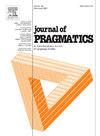法语和西班牙语自我修复和自我重构的句法研究:话语长度的影响
IF 1.7
1区 文学
0 LANGUAGE & LINGUISTICS
引用次数: 0
摘要
在这篇文章中,我们提出了一项自我修复和自我重塑的研究,该研究基于对近19,000个标记的语料库的分析,这些标记被完全分割成话语。该语料库包括两种语言,法语和西班牙语,这两种语言的代表性相等,并为这两种语言中的每一种提供了五种不同的交际环境(社会语言学访谈,公开访谈,工作会议,朋友之间的会议和服务互动)。这种语料库架构,以及将整个语料库分割成话语,使我们能够指出一些以前没有描述过的关于单位长度对自我修复的影响的一般趋势。事实上,话语中标记的平均长度不仅预测了至少有一个自我修复的单位的比例,而且还模型化了自我修复的起始地点和类型:如果5个或更少标记的话语少于10%有自我修复,那么11到20个标记的话语中几乎有40%有自我修复,超过31个标记的话语中大约有70%有自我修复。此外,在具有5个或更少标记的话语中,自我修复最有可能没有重新表述,并且发生在没有谓词的单元中,而在具有超过11个标记的话语中,自我修复很可能有或没有重新表述,并且在谓词之后开始,朝向单元的中间。本文章由计算机程序翻译,如有差异,请以英文原文为准。
Syntactic study of self-repair and self-reformulation in French and Spanish: Effects of utterance length
In this article we propose a study of self-repair and self-reformulation based on the analysis of a corpus of nearly 19,000 tokens, fully segmented into utterances. This corpus includes two languages, French and Spanish, which are equally represented, and five different communicative contexts (sociolinguistic interview, public interview, work meeting, meeting between friends and service interaction) for each of these two languages. This corpus architecture, as well as the segmentation of the entire corpus into utterances, allows us to point out some general trends, not previously described, regarding the effect of unit length on self-repair. Indeed, the average length in tokens of the utterance not only predicts the proportion of units with at least one self-repair, but also models the site of initiation of self-repair and type: if less than 10 % of utterances with 5 tokens or less have self-repair, almost 40 % of utterances with between 11 and 20 tokens have self-repair, and about 70 % of utterances with more than 31 tokens have self-repair. Moreover, in utterances with 5 tokens or less, self-repair is most likely to be without reformulation and to occur in a unit without a predicate, whereas in utterances with more than 11 tokens self-repair is likely to be with or without reformulation and to be initiated after the predicate, towards the middle of the unit.
求助全文
通过发布文献求助,成功后即可免费获取论文全文。
去求助
来源期刊

Journal of Pragmatics
Multiple-
CiteScore
3.90
自引率
18.80%
发文量
219
期刊介绍:
Since 1977, the Journal of Pragmatics has provided a forum for bringing together a wide range of research in pragmatics, including cognitive pragmatics, corpus pragmatics, experimental pragmatics, historical pragmatics, interpersonal pragmatics, multimodal pragmatics, sociopragmatics, theoretical pragmatics and related fields. Our aim is to publish innovative pragmatic scholarship from all perspectives, which contributes to theories of how speakers produce and interpret language in different contexts drawing on attested data from a wide range of languages/cultures in different parts of the world. The Journal of Pragmatics also encourages work that uses attested language data to explore the relationship between pragmatics and neighbouring research areas such as semantics, discourse analysis, conversation analysis and ethnomethodology, interactional linguistics, sociolinguistics, linguistic anthropology, media studies, psychology, sociology, and the philosophy of language. Alongside full-length articles, discussion notes and book reviews, the journal welcomes proposals for high quality special issues in all areas of pragmatics which make a significant contribution to a topical or developing area at the cutting-edge of research.
 求助内容:
求助内容: 应助结果提醒方式:
应助结果提醒方式:


